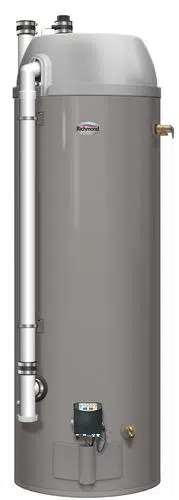Loading ...
Loading ...
Loading ...

8
Installing the water heater
Corrosive Atmospheres
The air in beauty shops, dry cleaning
establishments, photo processing
labs, and storage areas for liquid and
powdered bleaches or swimming pool
chemicals often contain such halogenated
hydrocarbons.
An air supply containing halogenated
hydrocarbons may be safe to breathe,
but when it passes through a gas flame
corrosive elements are released that
will shorten the life of any gas burning
appliance.
Propellants from common spray cans
or gas leaks from A/C and refrigeration
equipment are highly corrosive after
passing through a flame.
The water heater warranty is voided
when failure of the water heater is due to
operation in a corrosive atmosphere.
NOTICE: The water heater
should not be installed near
an air supply containing
halogenated hydrocarbons.
Thermal Expansion
Determine if a check valve exists in the
inlet water line. Check with your local
water utility company. It may have
been installed in the cold water line as a
separate back flow preventer, or it may
be part of a pressure reducing valve,
water meter or water softener. A check
valve located in the cold water inlet
line can cause what is referred to as a
“closed water system”. A cold water
inlet line with no check valve or back
flow prevention device is referred to as an
“open” water system.
As water is heated, it expands in volume
and creates an increase in the pressure
within the water system. This action is
referred to as “thermal expansion”. In
an “open” water system, expanding water
which exceeds the capacity of the water
heater flows back into the city main where
the pressure is easily dissipated.
A “closed water system”, however,
prevents the expanding water from
flowing back into the main supply line,
and the result of “thermal expansion”
can create a rapid and dangerous pressure
increase in the water heater and system
piping. This rapid pressure increase can
quickly reach the safety setting of the
relief valve, causing it to operate during
each heating cycle. Thermal expansion,
and the resulting rapid, and repeated
expansion and contraction of components
in the water heater and piping system can
cause premature failure of the relief valve,
and possibly the heater itself. Replacing
the relief valve will not correct the
problem!
The suggested method of controlling
thermal expansion is to install an
expansion tank in the cold water line
between the water heater and the check
valve (see illustration on right). The
expansion tank is designed with an
air cushion built in that compresses as
the system pressure increases, thereby
relieving the over pressure condition and
eliminating the repeated operation of the
relief valve. Other methods of controlling
thermal expansion are also available.
Contact your installing contractor, water
supplier or plumbing inspector for
additional information regarding this
subject.
Loading ...
Loading ...
Loading ...
